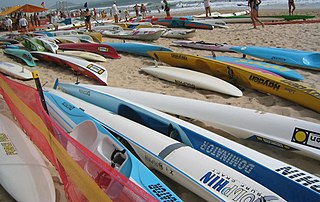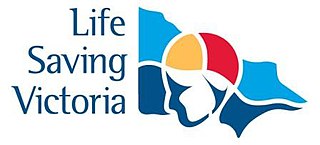
Surf lifesaving is a multifaceted movement that comprises key aspects of voluntary lifeguard services and competitive surf sport. Originating in early 20th century Australia, the movement has expanded globally to other countries including New Zealand, Ireland, South Africa, the United Kingdom. Surf lifesavers in Australia are colloquially known as "Clubbies".

A lifeguard is a rescuer who supervises the safety and rescue of swimmers, surfers, and other water sports participants such as in a swimming pool, water park, beach, spa, river and lake. Lifeguards are trained in swimming and CPR/AED first aid, certified in water rescue using a variety of aids and equipment depending on requirements of their particular venue. In some areas, lifeguards are part of the emergency services system to incidents and in some communities, lifeguards may function as the primary EMS provider.
Francesco ("Frank") Pia is an American lifeguard, recognized in the field for his research and training on ways to rescue people in trouble in the water. He is best known for the Pia carry, a widely used method of holding a drowning non-swimmer's head out of the water while swimming with the victim to shore; the instinctive drowning response which characterizes people on the verge of sinking underwater; and the RID factors in supervised drownings.
The Nova Scotia Lifeguard Service is a Canadian lifeguard service operating in Nova Scotia.

Toronto Parks, Forestry and Recreation (PFR) is the division of Toronto's municipal government responsible for maintaining the municipal park system and natural spaces, regulation of and provision of urban forestry services, and the delivery of recreational programming in city-operated facilities.
The Royal Life Saving Society UK is a drowning prevention charity founded in 1891 in the UK. It has had Royal Patronage since 1904.
Surf Life Saving Northern Region is the largest of four regions that make up Surf Life Saving New Zealand. As of the 2021/2022 season, it is made up of 18 clubs that look after 22 patrol locations from Ahipara to Raglan on the West Coast and from Whangārei Heads to Takapuna on the East Coast.

Swimming lessons are the process of learning to swim. In most countries there is a definition of a number of swimming levels that are reached in the process of the curriculum. The respective certificates of swimming tests are required for further training in aquatic abilities. Many countries have defined a minimum swimming level that children should reach by the end of primary education, in most cases with the help of school swimming classes being part of the normal curriculum.
The International Life Saving Federation (ILS) is an organisation for drowning prevention, water safety, lifesaving and lifesaving sports.

The United States Lifesaving Association is a nonprofit professional association of beach lifeguards and open water rescuers in the United States.

The Royal Life Saving Society Canada, commonly known as the Lifesaving Society or LSS, is a Canadian registered charity that works to prevent water-related injuries through various programs across Canada. The Lifesaving Society is an independent organization that is composed of ten provincial/territorial branches, tens of thousands of individual members, and over 4,000 affiliated swimming pools, waterfronts, schools and clubs. The Society helps prevent drowning and aquatic injury through its training programs, public education, drowning-prevention research, safety management and overseeing the sport of lifesaving.

Surf Life Saving Australia (SLSA) is an Australian not-for-profit community organisation that promotes water safety and provides surf rescue services.

Lifesaving is the act involving rescue, resuscitation and first aid. It often refers to water safety and aquatic rescue; however, it could include ice rescue, flood and river rescue, swimming pool rescue and other emergency medical services. Lifesaving also refers to sport where lifesavers compete based on skills, speed and teamwork. Lifesaving activities specialized in oceanic environment is called surf lifesaving or coastal lifesaving.

The Bronze Medallion is the second step towards the lifeguarding certification in Canada. The award is part of the Lifesaving Society's Bronze series of awards. It teaches an understanding of the lifesaving principles embodied in the four components of water rescue education: judgment, knowledge, skill, and fitness. It is the prerequisite for Bronze Cross; Standard First Aid with CPR-C and 16 years of age are the prerequisites for National Lifeguard Service. The Bronze Medallion endurance swim requirement is 400 meters (440 yd) in 12 minutes using any combination of strokes.

Life Saving Victoria is an Australian life saving organisation formed in 2002 from a merger of the Victorian Branch of the Royal Life Saving Society Australia and Surf Life Saving Victoria. Life Saving Victoria works to prevent drownings and other water related deaths and injuries in Victoria. Life Saving Victoria teaches local communities in Victoria about water safety, swimming and resuscitation. It also provides surf life saving services and patrols for beaches across the state. Life Saving Victoria is an emergency support agency to Victoria Police for water based emergencies.
The National Association for Cave Diving (NACD) was founded in 1968 with the goal of improving the safety of scuba diving in caves through training and education. A non-profit corporation, the NACD has its headquarters in Gainesville, Florida but is conducting its administration and operations from High Springs, Florida.
The International Surf Lifesaving Association (ISLA) is a nonprofit organization that advances professional lifesaving development to areas in need around the globe. ISLA uses latest technology to identify areas in need. ISLA advances development through lifeguard training programs and aquatic rescue operation consults, lifeguard exchanges, equipment donations, and by integrating with drowning prevention organizations to share information, techniques, stories, and culture.

Robert "Bob" MacKenzie Burnside was appointed the first president of the Surf Life Saving Association of America in 1964, which later became known as the United States Lifesaving Association. In 1965, he was appointed president of the National Surf Life Saving Association. In 1967, he developed the revolutionary plastic “Burnside Rescue Can”, now a standard for lifeguards worldwide and iconic symbol of beach lifeguarding. He was a champion swimmer who introduced the Malibu balsa surfboard to Australia. He wrote the History of Junior Lifeguarding.
A diver training standard is a document issued by a certification, registration regulation or quality assurance agency, that describes the prerequisites for participation, the aim of the training programme, the specific minimum competences that a candidate must display to be assessed as competent, and the minimum required experience that must be recorded before the candidate can be registered or certified at a specific grade by the agency. A standard is a description of the quality required of a product, or a way of doing something that has usually been derived from the experience of experts in a specific field. The purpose is to provide a reliable method for people to share a reasonably consistent expectation regarding the scope and quality of the product or service. Training standards allow objective comparison between the training provided by various agencies and the competence indicated by certification or registration to the specific standard, though in most cases, training and competence may exceed the minimum requirement much of the time, and variation between newly certified divers can be considerable, partly due to differences in the training, and partly due to qualities of the candidate. Training standards may narrowly prescribe the training, or may concentrate on assessment of exit level competence, and allow recognition of prior learning based on various forms of evidence. To be useful, a training standard must be sufficiently specific to allow agreement on the requirements by most readers reasonably competent in the field, including the instructors, assessors, and learners who must use it, the employers of persons trained, the potential customers, and any quality assurance personnel who may need to enforce it. A training standard may be linked to a code of practice referring to how the training should be carried out.

Lifesaving is an official discipline of the World Games, the Games with all the sports, recognized by the IOC but not yet in the Olympic program.













